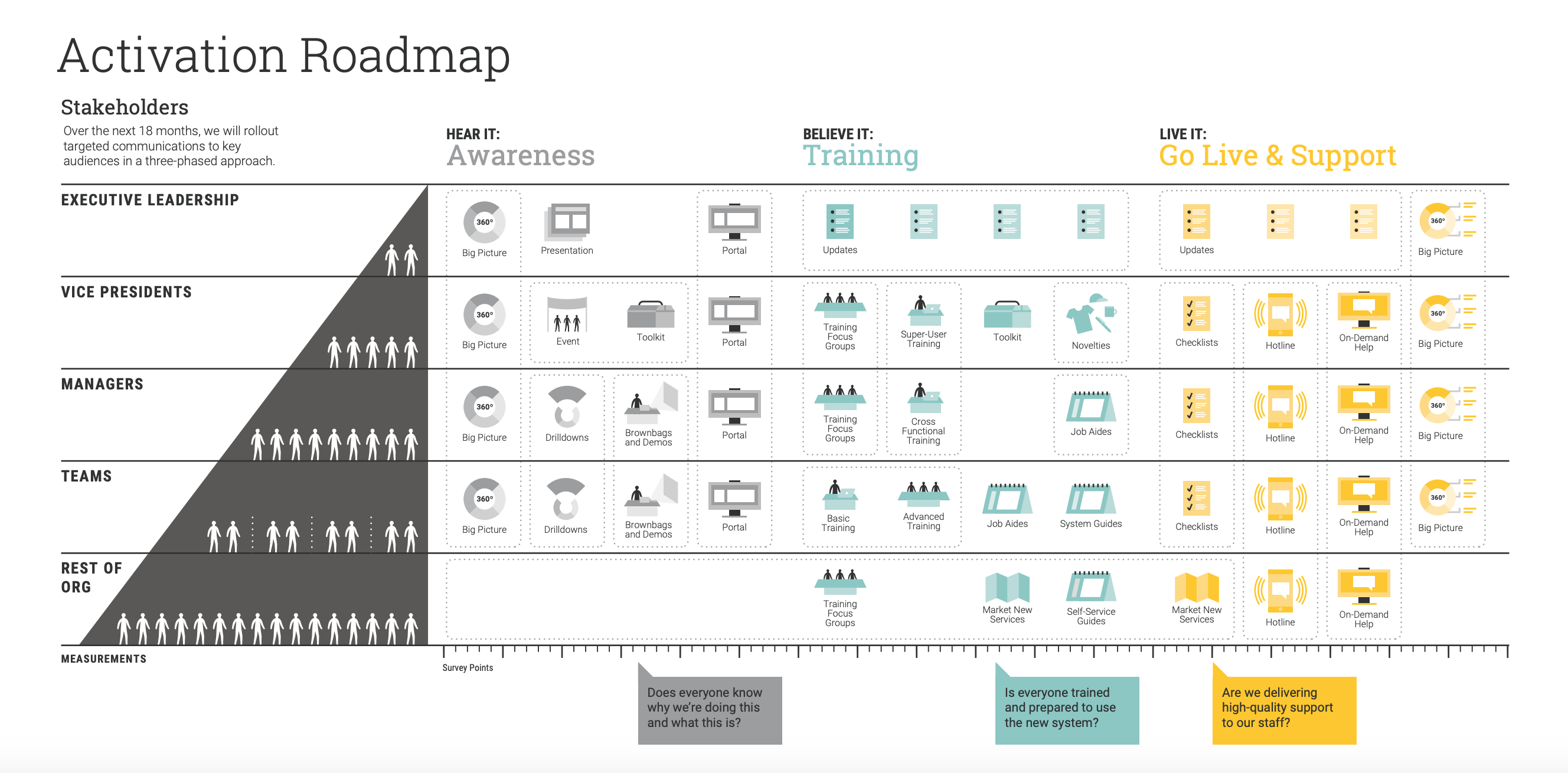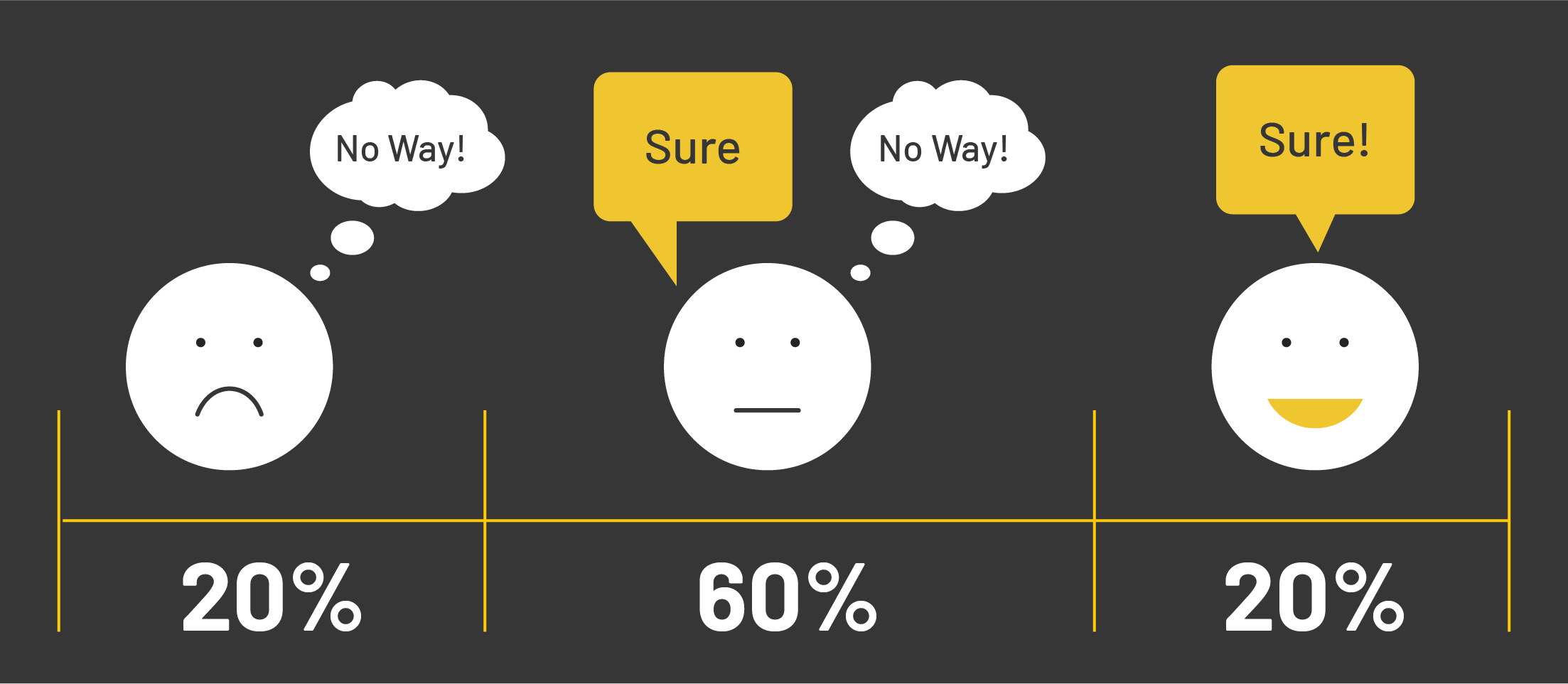Move your organization to the 20% that succeeds in implementing a strategy with these three powerful principles.
Last year, organizations spent almost $38 billion on strategy consulting.1 While an investment of this magnitude should guarantee successful strategy implementation, we know that about 80% of strategies fail.
Why is this? And what can we do about it?
Navigating the Obstacles
 Implementing strategy is never easy.
Implementing strategy is never easy.
At XPLANE, we help people overcome barriers such as apathy, risk avoidance, and a “what’s in it for me” attitude to get on board with strategy.
We’ve found, too, that people often have a muddy view of where their organization is headed.
But if they can see the mountain they’re headed to in the first place, they can also see the obstacles—and learn ways to navigate around them.
Why Do Most Strategies Fail?
In over 25 years of working with clients, we’ve found three main reasons strategies fail:
- No line of sight or clear vision. Employees want to know where the organization is headed, how they’re going to get there, why they’re making a change, what’s in it for them, and ultimately, their role in bringing a strategy to life.Bottom line: A line of sight is critical. Amazingly, it continues to be overlooked.
- No activation plan. Organizations commit money, resources, and time to developing strategy, but invest little in implementing that strategy. Strategy demands more than a three-ring binder, a presentation, and a wish for good luck.Bottom line: Investing in continuous education and enlightenment around strategy is essential.
- Lack of employee engagement. As organizations become less hierarchical, we see employees becoming more empowered. They want to be involved in the process—and in meaningful ways.Bottom line: Engaging employees in strategy activation makes them more likely to support change.
How to Overcome Strategy Failure
In our experience, making strategy take off—and stick—comes down to three principles.
Principle #1: Design for Humans (The Navigation System)
As humans, we are accustomed to taking journeys. It’s a universally understood metaphor that helps us understand where we need to go, how we’ll get there, and what the plan is.
A strong strategy navigation system consists of multiple elements:
 A mission or purpose. Organizations tend to have one true North that points the way to what’s right and what’s wrong. When in doubt—when a strategy is murky or when circumstances change—this should be an organization’s compass.
A mission or purpose. Organizations tend to have one true North that points the way to what’s right and what’s wrong. When in doubt—when a strategy is murky or when circumstances change—this should be an organization’s compass.
 A clear vision. Many people wonder what vision means. Is it a far-off thing, or is it short term? At XPLANE, a clear vision means a destination far enough out that you have to imagine it, but achievable enough that people can carry it out—whether that be three years, five years, or seven years from now.
A clear vision. Many people wonder what vision means. Is it a far-off thing, or is it short term? At XPLANE, a clear vision means a destination far enough out that you have to imagine it, but achievable enough that people can carry it out—whether that be three years, five years, or seven years from now.
 A strategy. Strategy is the route you pick to get to a destination. While there are many ways to get where you want to go, part of the art of strategy design is identifying the best route for your organization to get from Point A to Point B.
A strategy. Strategy is the route you pick to get to a destination. While there are many ways to get where you want to go, part of the art of strategy design is identifying the best route for your organization to get from Point A to Point B.
 A road map. A road map takes strategy and breaks it into smaller, more digestible pieces. Where are we going first? Where are we going next? While we never finish a journey in a day, we want to understand what we’re supposed to accomplish in this day.
A road map. A road map takes strategy and breaks it into smaller, more digestible pieces. Where are we going first? Where are we going next? While we never finish a journey in a day, we want to understand what we’re supposed to accomplish in this day.
 A role map. Finally, and probably most importantly, is something organizations often lack: a role map, which helps define an individual’s role in the journey. This is critical, since very few folks have a clear understanding of their role in the bigger process.
A role map. Finally, and probably most importantly, is something organizations often lack: a role map, which helps define an individual’s role in the journey. This is critical, since very few folks have a clear understanding of their role in the bigger process.
Principle #2: Know How Humans Learn (The Activation Curve)
Rooted in learning theory and in understanding how humans actually learn information and change behaviors, the activation curve gives us a road map to what strategy activation can and should look like.
 A typical strategy rollout generally happens via town hall, email, or presentation—but this only gets us to the first step of building awareness in strategy activation.
A typical strategy rollout generally happens via town hall, email, or presentation—but this only gets us to the first step of building awareness in strategy activation.
To go all the way, we need to help people hear, believe, and subsequently live the change we’re trying to make.
Phase 1: Hear the Change
In this phase, we need to communicate information and get people to hear it and act on it.
Empathy and design thinking tools can help with communication. These tools provide insights that help people hear, understand, accept, and finally realize the change is a better route forward.
It’s at this point where employees can move forward in alignment and activate the new strategy or behavior change.
Phase 2: Believe the Change
In this phase, it’s about getting people to believe and start using new behaviors, while internalizing the fact that the new way is better than the old way.
It’s imperative we help people acquire new skills and create opportunities for people to apply the new skills, behaviors, techniques, and processes.
Phase 3: Live the Change
Creating feedback loops that help individuals and the organization internalize knowledge is the critical next step.
This is where we start to live the change—the point at which people have now integrated the change into their ways of working.
As leaders of change, this is when we know we’ve actually reached the finish line. It’s not when we throw a strategy over the wall, but when the strategy becomes how we work every day.
When that happens, you can start the next curve, begin looking into the future, and think about how to improve things from there.

“It’s important to note, to activate a strategy, leaders must invest across all three phases of the activation curve. They need to think methodically about how to create interventions at each of these stages to get people along the route”.
Principle #3: Get Humans Invested (Employee Engagement)
When a change is launched within an organization, we tend to see the 80/20 rule in action.
The 80/20 Rule

About 20% of folks in the organization are wired to be enthusiastic for change. Those folks say, “Sure, let’s do this. This is good for me. We’re going to be better off.” They are at the front of the change process.
We also see, perhaps not as visibly, 20% of folks who are resistant. These folks are not going to advertise that they’re in the “no way” space, but they’re there.
They are asking themselves, “Why should I change? There’s too much risk in it for me, and management oftentimes doesn’t get it. They don’t see what we’re doing here on the ground. No way am I going to do this. I’m just going to sit back and let this happen.”
So we now have 20% of the organization working against the strategy activation process.
This is a problem, but I would suggest this isn’t the biggest problem we have.
The Troublesome Middle
The biggest problem is the group in the middle—the 60% who are sitting on the fence.
Publicly, they might be saying, “Sure, we’re on board.” But privately, they’re thinking, “I’m going to wait this out and see.”
This is the group that must be persuaded that the strategy is a good idea. They need to understand what it is that we’re doing. They need to understand what’s in it for them.
Given this, you can imagine that change is challenging. That’s because 20% of folks are not going to drag the other 80% forward.
We have to engage the 60%.
If we can get half of them, we’re well on the way to getting there.
If we can get all of them, the organization will be in the 20% that succeeds.
Want to Learn More?
Bringing strategy to life is exciting and challenging.
While we know that a strong navigation system and a solid understanding of how humans learn are essential to implementing strategy, how do we actually engage that noncommittal 60%?
This webinar answers that question.
In addition to the material covered in this post, our latest webinar elaborates on eight proven ways to engage employees and get them invested in moving forward.
If you have questions or comments on this post, please reach out to us. We’re all about helping you get the results you want.
For a deeper dive into strategy activation, we also recommend the following posts:
- What is Strategy? (a strategy primer)
- Two Fun Ways to Get Your Strategy Off the Ground (how to make strategy fun—and effective)
1Consultancy.org, The Global Consulting Market
